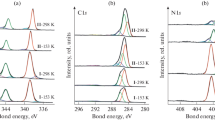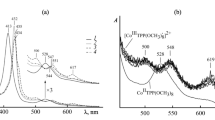Abstract
IN the course of the reduction of inorganic compounds the electron is always accepted by the lowest unoccupied (or singly occupied) orbital in the depolarizing particle, regardless of whether this orbital is localized in the central metal atom (or some ligand-atom) or whether it is an unlocalized molecular orbital. After the acceptance of the electron, a rearrangement of electrons and ligands takes place leading to the most stable configuration of the particle with one more electron formed in the reduction. The rate and mechanism of the electrode process depend on the rate and mechanism of this rearrangement.
Similar content being viewed by others
References
Vlček, A. A., Chem. listy, 49, 479 (1955); Coll. Czech. Chem. Comm., 20, 894 (1955); J. Electrochem. Soc., 102, 354 (1955).
Kalousek, M., Chem. listy, 40, 149 (1946); Coll. Czech. Chem. Comm., 13, 107 (1948).
Hume, D. M., and Kolthoff, I. M., J. Amer. Chem. Soc., 72, 4423 (1950).
Author information
Authors and Affiliations
Rights and permissions
About this article
Cite this article
VLČEK, A. Formation and Reduction of Zero-Valent Metal Complexes studied Polarographically. Nature 177, 1043–1045 (1956). https://doi.org/10.1038/1771043a0
Issue Date:
DOI: https://doi.org/10.1038/1771043a0
- Springer Nature Limited
This article is cited by
-
The supramolecular redox functions of metallomacromolecules
Journal of Leather Science and Engineering (2020)
-
Electrochemical reduction of Pt(CN) 4 2− ions in molten sodium-potassium cyanide eutectic
Journal of Applied Electrochemistry (1977)
-
Valence vibrations of the NO groups and ESR spectra of nitrosyl complexes of iron and chromium
Bulletin of the Academy of Sciences of the USSR Division of Chemical Science (1973)
-
Extinktionskurve des [Co(I) (Dyp)2] ClO4-Komplexes
Die Naturwissenschaften (1959)





